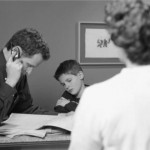“Be creative, be brave, and make up your own solutions.”
~ Madlyn Tombs, Pastor
Parents of people with disabilities have had to call upon creative resources throughout the life of their child. “Inventing the future” usually requires parents and their son or daughter to look beyond “the system”, beyond conventional answers, and requires them to consider anything that works.
Adolescence is a time of independence, a time when young adults begin to take more responsibility for meeting their own needs. Many young adults with disabilities begin to “strike out on their own” and seek less interference and involvement from their parents. Greater independence means higher risk. Risk taking is an essential component of adolescence and an important component of gaining independence.
When young adults with disabilities move from the school system into the community, their parents experience the same feelings that all parents do when it is time to “let go” and allow their kids to try things on their own. Letting sons and daughters with disabilities “try their own wings” can be more frightening because they have usually been more dependent on others.
Some parents are afraid their sons and daughters can’t make it without them. Others fear transition because change involves risk and they’re afraid their young adult may fail in some new task, be injured, or treated poorly. No parent wants to expose a young person to risk, especially one who has a higher than average chance of failing. Yet most parents know that risk-taking is essential for the long-term development of social and personal competence.
The passage from childhood to adulthood for all of us involves the ‘dignity of risk’ – the right to make mistakes and learn from them.”
Parents’ fears about physical or emotional harm are real, but protecting young people from reasonable risks robs them of an opportunity to become as independent as possible as they transition to adulthood.
The negative consequences of shielding young adults from taking risks can be more damaging than the consequences of an occasional mistake or failure. To prepare for the independence all adolescents strive for, opportunities to practice should be given prior to adolescence. A child may want to spend 2 weeks away at camp, which might terrify parents. Allowing the child to spend weekends camping with friends or spending a few nights away from home visiting a relative could gradually increase confidence in her or his independence. Breaking a desired goal into smaller steps helps build confidence and supports families as they enter this tough transition to independence.
While young adults are preparing to transition into the community, parents’ need for support and information may be as great or greater than they were when their child’s disability was first diagnosed. The support of other parents who are facing the same decisions and risks can be very valuable.
LETTING GO
Although it is especially difficult for you to allow and encourage your youth with disabilities to strike out on their own, it is easier when preparations have been made in advance. You will be less traumatized if you view “letting go” as a process and use transition planning to provide an approach that lays adequate groundwork for successful independence.
As your youth moves towards adulthood and independence, you can encourage them to make choices and discipline yourself not to interfere. Even if you are afraid they may fail at some new task or be treated poorly by others, you must recognize that reasonable risk-taking is essential for their personal growth, ultimate well-being, and long-term happiness.
The goals and objectives of the transition IEP can include specifics that address concerns about their ability to function safely on their own. When the transition plan is being developed or reviewed, you have the opportunity and obligation to make certain those concerns are addressed. As the plan is implemented and monitored, you can assess their progress as they: make choices; experience consequences; evaluate outcomes and apply what they learned to new circumstances.
When you let your youth make choices, you may experience feelings of fear, anxiety, and insecurity that match the emotional turmoil that came when they were first diagnosed with a disability. You may find it valuable to turn to other parents who are facing the challenges of transition for encouragement and support. You will find renewed strength when you share your feelings with others who understand your fears and hopes. You can sympathize and reassure one another when difficulties arise and celebrate together when positive accomplishments are made.
As you loosen your grip, you embark on a new leg of your journey in experiences with disabilities. It does not need to weaken the parent-child relationship but will change it to some degree. The love that once moved you to protect your youth will now motivate you to support, encourage, and respect them as they maximize their efforts toward independence.
“We don’t have a clue as to what people’s limits are. All the tests, stopwatches, and finish lines in the world can’t measure human potential.
When someone is pursuing their dream, they’ll go beyond what seem to be their limitations. The potential that exists within us is limitless and largely untapped.”
Robert J Kriegel & Louis Patler
“If It Ain’t Broke…Break It!”
This content is taken from the Utah Parent Center handbook:
From NO Where to KNOW Where: A Parent Handbook for the Transition to
Adult Life.

